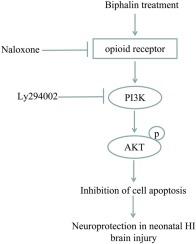Journal of Chemical Neuroanatomy ( IF 2.7 ) Pub Date : 2021-05-14 , DOI: 10.1016/j.jchemneu.2021.101967 Jin-Jia Zhang 1 , Yuan Li 1 , Su Chen 1 , Xiao-Fei Yang 1 , Jia-Wei Min 1

|
Previous studies have demonstrated that the activation of delta opioid receptors is neuroprotective against neonatal hypoxia-ischemia (HI) brain injury. The aim of this study was to investigate the neuroprotective effects of biphalin, a dimeric opioid peptide, in a mouse model of neonatal HI and the underlying mechanisms. On postnatal day 10, mouse pups were subjected to unilateral carotid artery ligation followed by 1 h of hypoxia (10 % O2 in N2). For treatment, biphalin (5 mg/kg, 10 mg/kg, 20 mg/kg) was administered intraperitoneally immediately after HI. The opioid antagonist naloxone or phosphatidylinositol-3-kinase inhibitor Ly294002 was administered to determine the underlying mechanisms. Infarct volume, brain edema, phosphorylated Akt and apoptosis-related proteins levels were evaluated by using a combination of 2,3,5-triphenyltetrazolium chloride staining, brain water content and Western blotting at 24 h after HI. The long-term effects of biphalin were evaluated by brain atrophy measurement, Nissl staining and neurobehavioral tests at 3 weeks post-HI. Biphalin (10 mg/kg) significantly reduced the infarct volume and ameliorated brain edema. Biphalin also had long-term protective effects against the loss of ipsilateral brain tissue and resulted in improvements in neurobehavioral outcomes. However, naloxone or Ly294002 abrogated the neuroprotective effects of biphalin. Furthermore, biphalin treatment significantly preserved phosphorylated Akt expression, increased Bcl-2 levels, and decreased Bax and cleaved caspase 3 levels after HI. These effects were also reversed by naloxone and Ly294002 respectively. In conclusion, biphalin protects against HI brain injury in neonatal mice, which might be through activation of the opioid receptor/phosphatidylinositol-3-kinase/Akt signaling pathway.
中文翻译:

Biphalin,一种二聚阿片肽,通过激活 PI3K/Akt 信号通路减轻小鼠新生儿缺氧缺血性脑损伤
先前的研究表明,δ 阿片受体的激活对新生儿缺氧缺血 (HI) 脑损伤具有神经保护作用。本研究的目的是研究双酚(一种二聚阿片肽)在新生儿 HI 小鼠模型中的神经保护作用及其潜在机制。在出生后第 10 天,对小鼠幼崽进行单侧颈动脉结扎,然后进行 1 小时的缺氧(N 2 中10 % O 2)。对于治疗,在 HI 后立即腹膜内施用双酚(5 mg/kg、10 mg/kg、20 mg/kg)。给予阿片拮抗剂纳洛酮或磷脂酰肌醇-3-激酶抑制剂 Ly294002 以确定潜在机制。在 HI 后 24 小时,通过使用 2,3,5-三苯基四唑氯化物染色、脑含水量和蛋白质印迹的组合评估梗塞体积、脑水肿、磷酸化 Akt 和凋亡相关蛋白水平。在 HI 后 3 周,通过脑萎缩测量、Nissl 染色和神经行为测试来评估 biphalin 的长期影响。Biphalin (10 mg/kg) 显着减少梗死体积并改善脑水肿。Biphalin 还具有防止同侧脑组织损失的长期保护作用,并导致神经行为结果的改善。然而,纳洛酮或 Ly294002 消除了双酚的神经保护作用。此外,双酚处理显着保留了磷酸化的 Akt 表达,增加了 Bcl-2 水平,并降低了 HI 后的 Bax 和切割的 caspase 3 水平。纳洛酮和 Ly294002 也分别逆转了这些作用。总之,biphalin 保护新生小鼠免受 HI 脑损伤,这可能是通过激活阿片受体/磷脂酰肌醇-3-激酶/Akt 信号通路。并在 HI 后降低 Bax 和裂解的 caspase 3 水平。纳洛酮和 Ly294002 也分别逆转了这些作用。总之,biphalin 保护新生小鼠免受 HI 脑损伤,这可能是通过激活阿片受体/磷脂酰肌醇-3-激酶/Akt 信号通路。并在 HI 后降低 Bax 和裂解的 caspase 3 水平。纳洛酮和 Ly294002 也分别逆转了这些作用。总之,biphalin 保护新生小鼠免受 HI 脑损伤,这可能是通过激活阿片受体/磷脂酰肌醇-3-激酶/Akt 信号通路。











































 京公网安备 11010802027423号
京公网安备 11010802027423号